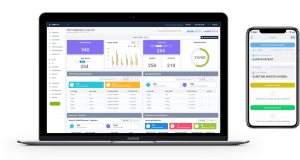The EVV Deadline is Just Around the Corner

If you are in the home health business, chances are you’ve heard of EVV and have created a plan on how to tackle it. If not, your time is running out! The EVV deadline for agencies receiving government reimbursements for personal care services is January 1, 2021.
What is EVV Again?
EVV stands for Electronic Visit Verification. Essentially, it is a technology that verifies where and when a caregiver begins services for a client and when they clock out. This provides a breadcrumb trail that proves care was given at a certain place, at a certain time.
The need arose from abuse from some providers inflating and making up timesheets. It became too easy for an unethical agency owner to pencil in false service times and then bill Medicaid / Medicare for the services. The result was that billions of dollars were being fraudulently or inappropriately collected by agencies.
Now with EVV technology, there is no disputing that a caregiver is at the location when clocking in/out via a landline or GPS mobile app.
Why is EVV Becoming a Requirement?
Many states have already begun requiring electronic visit verification for registered agencies, but the EVV requirement is about to become a national mandate. In the last couple of months of President Obama’s time in office, he signed the 21st Century Cures Act, which contained a lot of legislation.
Pertaining to home health, the Cures Act will require that all home health agencies and personal care services that accept government reimbursements will have to have an EVV solution in place by the end of 2019 (now Jan 1, 2021, due to the delay signed by Congress) for personal care and 2023 for home health agencies.
Here is the Cures Act and EVV legislation from the U.S. Congress website in relation to the Cures Act if you’d like to research further.
State Mandates and their EVV Implementations
Some states like Texas and South Carolina had mandated EVV long before this issue was ever a part of federal home care legislation. Now that there is a national mandate in the near future, a few states are still in the process of creating EVV policies, while most others have already chosen their EVV vendor/aggregator. Make sure you check what EVV vendor or aggregator your state will be using. The multiple-vendor approach is a popular choice among many states.
There are three potential ways that a state can implement a multiple-vendor approach.
- Provider Choice. Providers choose their EVV of choice and ensure that all standards are met. Additionally, a common format export of data may be required by the state.
- State Overseer. State overseer of EVV in an open-choice model. An organization (state or private sector) with no conflicts of interest will verify and oversee the data and quality of data coming from the various EVV vendors in a single database or data warehouse, and provide data insights to the state.
- Approved Vendor List. The state creates an approved vendor list. The list should not be static but rather allows for different vendors to either be rewarded or punished for good or poor performance and design.
Embrace EVV, It’s Coming
Some home care providers have been resistant to the idea of EVV, and like it or not, it’s coming very soon. However, it’s not a bad thing, and it can actually make your business more profitable and efficient.
EVV allows you to automatically eliminate paper time sheets, record visits, and create billing and payroll data at the push of a button. Additionally, if an audit comes your way, you won’t have to worry about digging out stacks of paper, you can just download your data in minutes. Most providers that use EVV find ways to save hours of admin time, cut overpayments, and find ways to increase revenue. So embrace the technology, it’s good for you.
What types of EVV Technologies Exist?
Originally, EVV started out as a landline telephony technology that recorded the time called in and out at the client’s home. That method is still widely used today. However, with the invention of smartphones, more and more visits are being verified through smartphones using GPS location. This is by far the fastest-growing method. Also, computers and tablets can be used for verified visits.
Additional technologies include non-smartphone cell service triangulation, fixed-device check-ins, and now voice-bot check-ins. The non-smartphone method occurs when a caregiver calls through a non-smartphone, and then the cell carriers use the towers to locate where the caregiver is. With a fixed device, some areas don’t have cell service or landline, so caregivers will scan a barcode, record a number or scan an RFID card to clock in and out.
While you may not need all of those technologies, some states are requiring multiple technologies in an EVV solution. Make sure that at the very least there is both telephony and mobile visit verification in your EVV solution.
Still Looking for an EVV Software?
CareTime’s got you covered. CareTime offers one of the best home care software solutions in the marketplace with a built-in EVV system. We also can provide customized software and integrations for large organizations. We are already integrated with many EVV aggregators for various states. Talk to us about how we can help you get ahead of the compliance requirement for EVV. Find out more about CareTime’s Electronic Visit Verification (EVV) software solution.
Blog Post Tags
Electronic Visit Verification (EVV)Get Awesome Content Delivered Straight to Your Inbox!
Posts by topic
- Home Care Management
- Electronic Visit Verification (EVV)
- billing
- EVV software
- Caregiver Recruitment and Retention
- payor types
- Home Care Management for Franchises
- Revenue Growth
- Compliance
- Revenue Cycle Management
- Business
- medicaid
- Medical Billing Software
- Medicare
- payor
- Press Release
- Homecare Homebase
- Marketing & Sales
- RCM
- Scheduling
- caregiver registry
- cdpap
- legislation
- regulations
- Events
- Lifestyle
- Operations
- leadership
- partners
- referrals See All See Less

.png?width=620&height=620&name=Grow-Your-Caregiver-Network-eBook-Download%20(1).png)


